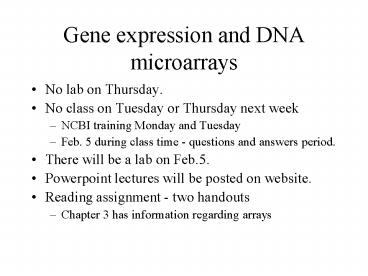Gene expression and DNA microarrays - PowerPoint PPT Presentation
1 / 18
Title:
Gene expression and DNA microarrays
Description:
Gene expression and DNA microarrays – PowerPoint PPT presentation
Number of Views:98
Avg rating:3.0/5.0
Title: Gene expression and DNA microarrays
1
Gene expression and DNA microarrays
- No lab on Thursday.
- No class on Tuesday or Thursday next week
- NCBI training Monday and Tuesday
- Feb. 5 during class time - questions and answers
period. - There will be a lab on Feb.5.
- Powerpoint lectures will be posted on website.
- Reading assignment - two handouts
- Chapter 3 has information regarding arrays
2
Genome of the week
- E. coli O157H7.
- Causes haemorrhagic colitis
- Initially identified in 1982 during an outbreak
of severe bloody diarrhea. - Linked to contaminated ground beef from Michigan
- 75,000 cases per year
3
- Two different strains sequenced - link is to the
U.S. sequence. - Major findings
- Comparison of E. coli O157H7 with E. coli K-12
(common lab strain) found that the O157H7 genome
is 1Mb larger than K-12 and contains 1,387
genes specific for O157H7. - Genomes share a 4.1 Mb backbone with species
specific DNA interspersed throughout the genome - K-islands - specific to K-12 (0.53Mb)
- O-islands - specific
- Lateral transfer of DNA occurs much more
frequently than previously thought. Especially
high for enterobacteria. - O-island specific DNA encoded genes required for
virulence and a large number of phage and phage
associated genes.
4
Gene expression
- What is gene expression?
- Methods for measuring a single gene.
- Northern Blots
- Reporter genes
- Quantitative RT-PCR
- Operons, regulons, and stimulons.
- DNA microarrays.
- Expression profiling
- Identifying protein binding sites.
- Comparing gene content of different strains.
5
What is gene expression?
- The amount of RNA produced from a gene.
- Level of RNA produced from a gene is controlled
by - Transcription
- Degradation
- Transcriptome - Expressed transcripts in a cell
under defined experimental conditions. - mRNA(5-10 of total RNA).
- rRNA, tRNA - make up most of total RNA
- scRNA (protein secretion), tmRNA (rescue stalled
ribosomes).
6
Analysis of gene expression at the single gene
level.
- Northern Blots
- Measure RNA levels by hybridization of a labeled
probe to total RNA. - Reporter Genes
- Use of an enzyme to measure the amount of
transcription from a promoter. - Quantitative RT-PCR.
- Brief review pages - 158-160.
7
Regulons and Stimulons
- Operon - group of genes co-expressed on a single
transcript. - One location of the genome
- Regulon - genes that are regulated by a single
transcription factor. - Genes and operons throughout the genome
- Stimulon - collection of genes that are regulated
in response to environmental changes. - Can be multiple regulons affected at once.
- Regulatory network - alternative term for
regulon.
8
Assaying the regulation of 1000s of genes in a
single experiment
- DNA microarrays
- DNA molecules printed at high density used to
determine the level of RNA or DNA in a sample. - Can be thought of a reverse Northern blots
- Other technologies (described in chapter 3).
- SAGE
- Microbeads
9
DNA Microarrays -Introduction
- Spotted DNA arrays (glass slides)
- Competitive binding of samples
- Fluorescent detection - Cy3 and Cy5
- Small sample sizes (10-30µl).
- PCR or cDNA arrays
- Long oligonucleotide arrays
- Better specificity, cheaper, easier to work with.
- Short oligonucleotide arrays
- ex. Affymetrix
- DNA spotted onto nylon membranes (macroarrays)
10
Microarray experimental overview
11
Hybridization basic concept
The ability of two strands to hybridize is
dependent on their complementarity. More
complementaritybetter hybridization
12
Labeling RNA or DNA with Cy3 or Cy5.
- Cy3 and Cy5 - most often used fluorescent
molecules used to label samples for microarray
analysis. - Absorb light at one wavelength and emit at
another. - Emission and Excitation spectra do not overlap
significantly. - In arrays Cy3 and Cy5 are usually false colored
green (Cy3) and red (Cy5) for ease of
visualization.
13
More labeling
- Direct incorporation - incorporates Cy3-or
Cy5-dNTP directly into cDNA - RNA to cDNA - reverse transcriptase
- DNA to DNA - DNA polymerase
- Big problem - Cy3 and Cy5 are not incorporated
with same efficiency. - Indirect incorporation - preferred method.
- Incorporate an aminoallyl-dUTP molecule during
reverse transcription of RNA to cDNA. - Chemically couple Cy3 or Cy5 dye after cDNA is
made. - Coupling is efficient with both dyes.
14
Applications of DNA microarrays
- Expression profiling
- Determining the relative levels of RNA in two or
more samples. - DNA/DNA hybridizations
- Investigate gene content between different
strains - Determine gene dosage
- 16S arrays - microbial communities (being
developed). - Identification of protein binding sites
- ChIP-Chip. Immunoprecipitation of protein/DNA
complexes. Assaying those interactions with
microarrays.
15
B. subtilis DNA microarrays
- PCR generated microarrays using custom primers
(Sigma-Genosys). - Each PCR product represents a single gene.
- 4074 genes of 4101 on the array.
- Printed on Corning CMT-GAPS slides.
- 4 E. coli controls, each represented 15-20 times
on the array.
16
How a DNA microarray works
- Comparing the genome content of two B. subtilis
strains. - The two strains differ only by the fact that
JH642 is lysogenized with the bacteriophage SPb. - JH642 vs PY79 genomic DNA hybridization.
- PY79 does not contain SPb.
- SPb spots will be red.
17
JH642
PY79
Array size 16mm x16mm Spot size 150mM
18
SPb genes
E. coli control
JH642
PY79































